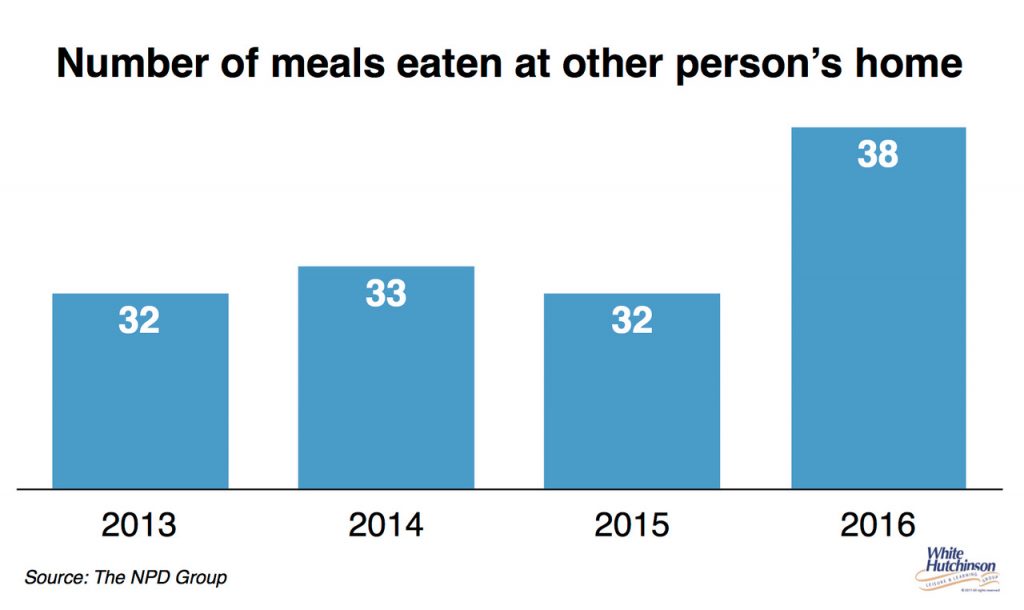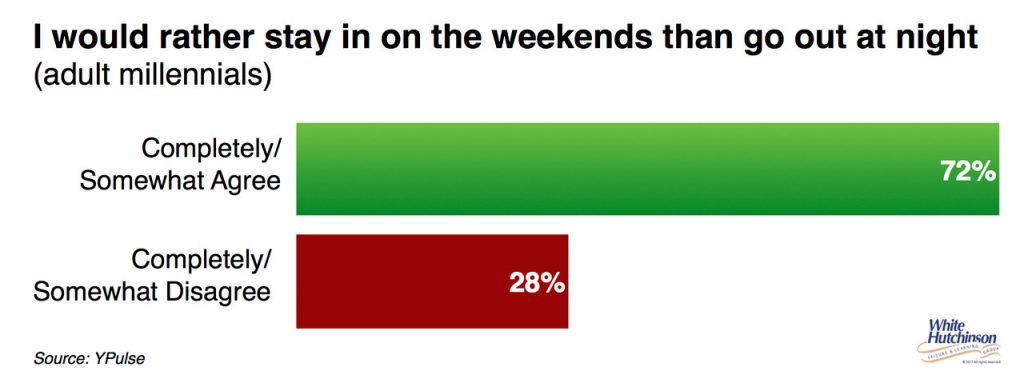Cocooning Is the New Going Out
Consumer Habits Already Affecting the Future – Part Two

By Randy White, CEO/White Hutchison Leisure & Learning Group
During the Great Recession that started back in 2007, people, and especially the younger generations, spent more time at home, watching movies and cable, playing video games and cooking meals. People did everything practical to keep things affordable and convenient in the comforts of their home cocoons. It turns out that now, even after the recession ended and the economy improved, they liked it so much they decided to continue staying home. It’s become a new leisure lifestyle for many.
Today, they have so many more toys to play with at home (mostly digital) than just a few years ago. Digital technologies enable us to do almost anything at home and also to have almost anything delivered to us, including groceries, restaurant meals and any product that a storefront on the Internet sells. A recent survey by Ypulse found that almost 3 in 4 (72 percent) of Millennials would rather stay in on the weekends than go out at night.
The “Hygge” Trend
We now have a new trend that is fueling staying at home called hygge, a Danish word and trend that refers to “the constant pursuit of homespun pleasures.” One hygge activity would be curling up in a blanket on the couch in cozy sweats with some enjoyable drink while binge-watching Netflix. It’s no wonder the Danes are considered the happiest people on earth. The hygge bug has caught on with Americans, too, as they have become increasingly more mindful of both their physical and emotional health.
2016 saw a significant growth in home industry product sales. “Today’s consumers are spending more time in the home and are willing to spend more for products that will help enhance their home lifestyle,” said Joe Derochowski, executive director and home industry analyst at The NPD Group. Consumers’ desire to create meaningful experiences in their homes has lead to significant sales growth in many home product categories as reported by NPD.
Derochowski says consumers are seeking home products that make a strong and positive impact on their lives and “that can solve the ‘I hate’ moments, feed the ‘I love’ thoughts and answer the ‘I wish’ pleas…”
 The hygge staying home trend has resulted in Americans eating in more and dining out less. Today, 76 percent of meals are eaten at home, whether that means preparing the meal there or purchasing the food from a restaurant to eat at home (often now delivered on demand rather than carry out). Dinner is especially home-centric with 81 percent of those meals eaten at home; of all dinners purchased at restaurants, nearly half are consumed at home.
The hygge staying home trend has resulted in Americans eating in more and dining out less. Today, 76 percent of meals are eaten at home, whether that means preparing the meal there or purchasing the food from a restaurant to eat at home (often now delivered on demand rather than carry out). Dinner is especially home-centric with 81 percent of those meals eaten at home; of all dinners purchased at restaurants, nearly half are consumed at home.
David Portalatin, a NPD Food Industry Analyst, speculated people are eating at home more often because they can do so many other things there now, too. They can work, shop, be entertained, etc. “This convenience allows for fewer trips out, so it just makes sense that they will eat at home more, too,” he explained.
 NPD’s eating-at-home data reveals another interesting trend: The number of meals eaten at other people’s homes has increased. Between 2013 and 2015, the average number of meals eaten at another person’s home varied between 32 and 33 meals per person each year. In 2016 it jumped by almost one-fifth to an average of 38 meals eaten at someone else’s home. Portalatin says he attributes this jump primarily to dinner, the most social meal occasion. This all ties back to the hygge trend of living a life connected to loved ones. He says eating at someone’s home more often allows for a casual approach to quality time with friends that prioritizes comfort.
NPD’s eating-at-home data reveals another interesting trend: The number of meals eaten at other people’s homes has increased. Between 2013 and 2015, the average number of meals eaten at another person’s home varied between 32 and 33 meals per person each year. In 2016 it jumped by almost one-fifth to an average of 38 meals eaten at someone else’s home. Portalatin says he attributes this jump primarily to dinner, the most social meal occasion. This all ties back to the hygge trend of living a life connected to loved ones. He says eating at someone’s home more often allows for a casual approach to quality time with friends that prioritizes comfort.
Besides streamed content, there is another technological draw to staying home. Consumers are spending more money on home-based technology like smart home devices, home networking, sound bars, broadband services and voice-activated virtual assistants like Alexa, all of which enhance their homes and the nesting lifestyle. These expenditures are growing faster than spending on mobile technologies like smartphones and accessories, cellular subscriptions, tablets, etc. This trend is certainly fueling consumers desire to consume media content at home. Eddie Hold, president of Connected Intelligence, describes the present as the “post-mobile era” where mobile is no longer the center of the tech universe.
When it comes to in-home video gaming, we’re see a “Netflixization” of gaming with services like Microsoft Xbox’s Game Pass and EA Access that offer unlimited access to games for a monthly fee. This new streaming model encourages game binging, a popular nesting pastime.
In addition, we’re seeing another hyggelig home trend: old-school games. These made up the fastest growing toy super category in 2016 with this games category growing 21 percent in 2016. Games are fun experiences that can be shared with friends and family. It doesn’t get more hyggelig than a night gathered around the coffee table to play some board game.
It looks like hygge is here to stay, and will probably only grow in its appeal. Home is at the intersection of experiences, human connections and a safe haven where people can refuel in these times of turmoil and seek safety and an escape from reality by retreating into the seclusion of their homes
In fact, futurist Faith Popcorn says there is now a new lifestyle trend of people called “Bunkering,” seeking safety and escape from reality by retreating to the seclusion of their homes. This is a more intensive staying at home trend than the cocooning trend she previously identified. When it comes to the idea of the safety of the home, just consider the fear that has been brought on by the attacks in Europe, natural disasters, multiple mass shootings in the U.S., other bad news, and most of all ISIS.
The New York Times recently ran a story titled, “Is Staying In the New Going Out?” Last year, there was a blog on the Huffington Post called “Staying In Is the New Going Out” that said to forget FOMO (the fear of missing out), and discussed JOMO (the joy of missing out) and just staying home. Another acronym has emerged, JOSH, the joy of staying home. A good night is fast becoming more about couch time than going out on the town. Welcome to Generation Homebody.
A recent study from the U.K. by Research Now, a market research firm, examined the differences in behavior and attitudes of 16- to 21-year-olds (post-Millennials) compared to other generations. What they found is that almost three-quarters (73 percent) of this younger age group prefer staying home to going out. They forgo regular nights out for nights in watching TV, streaming media and saving money for a big night out and special events.
However, their research found this trend is not limited to that young age group. It’s also true for the general population: 69 percent have the same preference for staying home, with the preference declining with age to 45 percent for over age 65. For post-Millennials, going out is an event, so they stay in in order to save up for one of the one-off big events or festivals.
Implications
Not all that many years ago, an FEC or other community leisure venue only had to worry about competition from the other centers in town. Then, the competition expanded to include all the digital entertainment options people had on their screens, both mobile and at home. At the same time, there was an increase in competitors and other out-of-home businesses, especially retailers, trying to become “experience destinations.” (We’ve now have the rise of retailers that offer entertainment such as bowling, Ferris wheels and ropes courses, and also have destination restaurants.) The competition has also broadened to include hyggeligging –– just staying home…the new “going out.”
What this all means is that the bar to get people out of the home and into your location (versus all the other experience options) is incrediblly high. As you read in part one in October (www.replaymag.com/randy-white-guest-essay-october-2017), mediocrity no longer works. In fact, good no longer works. The experience now has to be premium –– what we call High Fidelity –– to get the consumer to come and spend his limited free time and discretionary funds.
This is very positive news for community leisure venues that take food and drink seriously, considering them an anchor attraction. It means there’s more than a fighting chance to compete as a dining destination with all the restaurant chains.
The White Hutchinson Leisure & Learning Group is a multi-disciplinary firm specializing in feasibility, concept and brand development, design and consulting for entertainment facilities. Over the past 26 years, the company has worked for over 500 clients in 32 countries, and won 16 first-place design awards. It publishes an occasional Leisure eNewsletter and Tweets (@whitehutchinson); Randy blogs. He is also a founder, co-regent and presenter at Foundations Entertainment University, now in its 13th year. Randy can be reached at 816/931-1040, ext. 100, or via the company’s website at www.white hutchinson.com. © 2015 White Hutchinson Leisure & Learning Group

